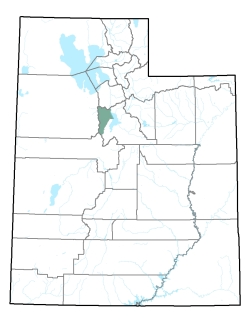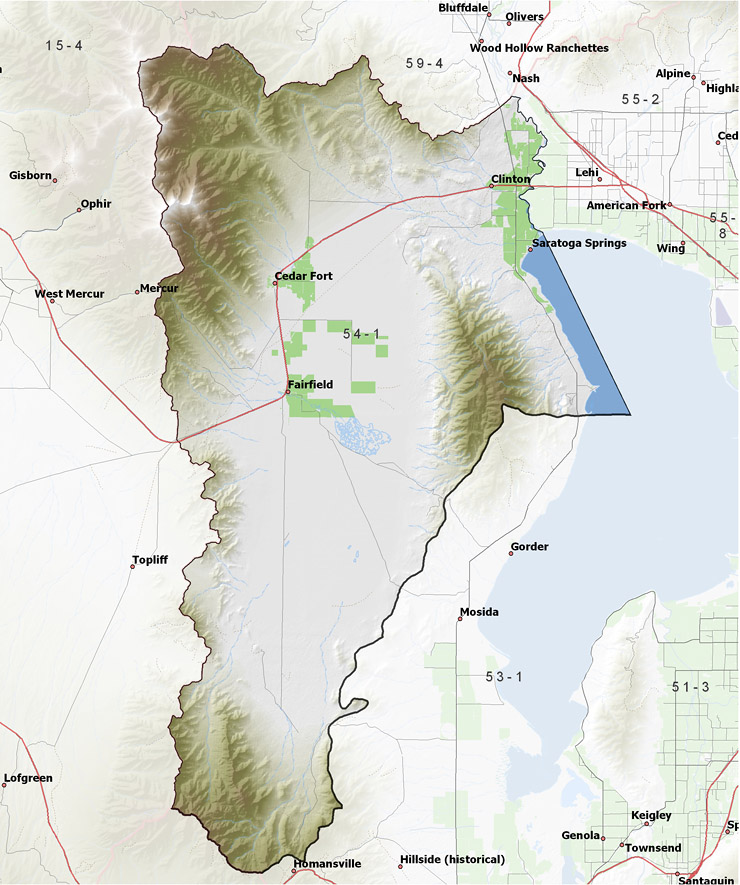AREA 54 - CEDAR VALLEYUpdated: November 3, 2022Recent changes and additions in red text |
|
|
MANAGEMENT A Proposed Determination of Water Rights book was published in 1975. No pre-trial orders or interlocutory decrees have been issued. There are several other decrees in this area, most notably a Utah Supreme Court decision in 1966 concerning the rights in Fairfield Springs. There is no state-administered distribution system in this area. This area is subject to the conditions of the Cedar Valley and Northern Utah Valley Groundwater Management Plan and the Utah Lake Water Distribution Plan (1993). Click here to see statistics for this area. SOURCES Surface and Ground Water - All supplies of water are fully appropriated. Non-consumptive use applications will be considered on their individual merits. Changes from surface to underground sources, and vice versa, are considered on their individual merits and in accordance with the Cedar Valley and Northern Utah Valley Groundwater Management Plan, with emphasis on their potential to interfere with existing rights and to ensure that there is no enlargement of the underlying rights. Fixed-time and temporary projects, especially those involving surface waters, must be handled by temporary change applications. Applicants are placed on notice that dry years may bring about a reduction of artesian pressure, therefore, well construction should accommodate the installation of submersible pumps. Applicants are placed on notice that development should be pursued as soon as possible, and requests for extensions of time in which to file proof will be critically reviewed after an initial five year period. Governor's Proclamation 2022-01 - On November 3, 2022, Governor Spencer Cox issued a proclamation suspending new appropriations of surplus and unappropriated waters in the Great Salt Lake Basin pursuant to Utah Code 73-6-1. To read the press release from the Governor's office, click here. To read the proclamation, click here. A report on the proclamation to suspend appropriations in Great Salt Lake Basin was published on November 22, 2023 and can be read here. To view a map of areas subject to the proclamation, click here.The following are excepted from the effect of this proclamation:
GROUNDWATER MANAGEMENT PLANS
GROUNDWATER CHANGE APPLICATIONS As a part of the groundwater management plan adopted on April 8, 2014, the State Engineer adopted several appropriation policy guidelines for the area. Some of those guidelines pertain to groundwater change applications:
GENERAL Applications are advertised in the Provo Daily Herald. The general irrigation diversion duty for this area, which the State Engineer uses for evaluation purposes, is 4.0 acre-feet per acre per year. The consumptive use requirement is determined from the publication Consumptive Use of Irrigated Crops in Utah, Research Report 145, Utah State University, 1994, unless the applicant submits other data for consideration. This area is administered by the Utah Lake-Jordan River Regional Office in Salt Lake City. Other requirements The Water Right applicant is strongly cautioned that other permits may be required before any physical development of a project can begin and it is the responsibility of the applicant to determine the applicability of and acquisition of such permits. In order to avoid delays and ensure that Water Right approvals conform to applicable local ordinances, applicants should contact local governmental entities in advance to determine what ordinances are in place that affect the proposed project and to make sure that Water Right filings conform to those ordinances. The approval of a Water Right application does not imply any approval of a project by any other governmental entity. Approval of the project proposed in the Water Right application should be obtained from local governmental entities as necessary to implement a project. REFERENCES Technical Publication No. 11, Ground Water in Northern Utah Valley, Utah: A Progress Report for the Period 1948-63; Utah Department of Natural Resources; 1965. Technical Publication No. 16, Ground-water Conditions in Cedar Valley, Utah; Utah Department of Natural Resources; 1967. Technical Publication No. 46, Water-Quality Reconnaissance of Surface Inflow to Utah Lake, Utah; Utah Department of Natural Resources; 1974. Technical Publication No. 80, Ground-water Resources of Northern Utah Valley, Utah; Utah Department of Natural Resources; 1985. Basic-Data Report No. 2, Records of Selected Wells and Springs, Selected Drillers Logs of Wells, and Chemical Analyses of Ground and Surface Waters, Northern Utah Valley, Utah; Utah State Engineer; 1962. Basic-Data Report No. 39, Selected Hydrologic Data for Northern Utah Valley, Utah, 1935-1982; Utah Department of Natural Resources; 1982. Water-Resources Investigative Report 95-4173, Simulated Effects of Proposed Ground-Water Pumping in 17 Basins in East-Central and Southern Nevada; U.S. Geological Survey; 1995 (viewing this document requires the DjVu browser plugin available from LizardTech) UGS Cooperative Report Special Study 109, The Geology of Cedar Valley, Utah County, Utah and Its Relation to Groundwater Conditions; Utah Geological Survey; 2004. UGS Special Study 145, Hydrogeology and Simulations of Groundwater Flow in Cedar Valley, Utah County, Utah; Utah Geological Survey; 2012. Scientific Investigations Report 2008-5049, Three-Dimensional Numerical Model of Ground-Water Flow in Northern Utah Valley, Utah County, Utah; U.S. Geological Survey; 2009. Scientific Investigations Report 2008-5197, Hydrology of Northern Utah Valley, Utah County, Utah, 1975-2005; U.S. Geological Survey; 2009. USGS Scientific Investigations Report 2014-5213, Steady-State Numerical Groundwater Flow Model of the Great Basin Carbonate and Alluvial Aquifer System; 2014. USGS Scientific Investigations Report 2017-5072, Groundwater Model of the Great Basin Carbonate and Alluvial Aquifer System Version 3.0: Incorporating Revisions in Southwestern Utah and East Central Nevada; 2017. MODELING Regional Ground-Water Flow, Carbonate-Rock Province, Nevada, Utah, and Adjacent States; USGS Open-File Reports 93-170 and 93-420; 1993. Northern Utah Valley Ground-water Flow Model, 1985. Three-Dimensional Numberical Model of Ground-Water Flow in Northern Utah Valley, Utah County, Utah, 2008 Cedar Valley Groundwater Flow Model, 2012. PREVIOUS PAGE UPDATES November 26, 2014 |

Policy area in green,
click on the map for more detail DESCRIPTION Extending from T4S to T10S in western Utah County, this area involves the flows of intermittent streams eastward from the Oquirrh Mountains into the valley. The area is bordered on the north by the Salt Lake Valley, on the west by Rush Valley, and on the east by Utah Lake and Goshen Valley. The highest point in the area is 10,589 foot Lowe Peak, while the lowest is the surface of Utah Lake at about 4,490 feet, giving a total relief of about 6,100 feet. |
|
|
|
